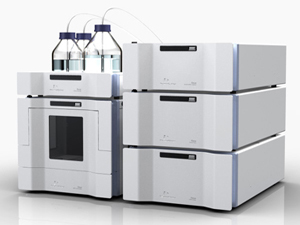High-Performance Liquid Chromatography (HPLC)
HPLC is used to separate, identify, and quantify compounds in a mixture that are dissolved in a solution. An HPLC separation involves the injection of a small volume of liquid sample into an HPLC column packed with particles (typically 3 to 5 microns in diameter) called the stationary phase. Individual components of the sample flow through the HPLC column with a liquid (mobile phase) under high pressure delivered by an HPLC pump. Typical flow rates of the liquid mobile phase used for routine analysis in QC and QA laboratories are 1–2 mL/min.
HPLC separations work
The various chemical and/or physical interactions between the molecules and the packing particles define the HPLC column selectivity properties. There is a wide variety of HPLC columns and packing materials to suit an ever-expanding range of applications. The selectivity of the column’s chemistry enables components within a test sample to be separated from one another. These separated components are then detected and measured on exiting the column by an HPLC detector.


